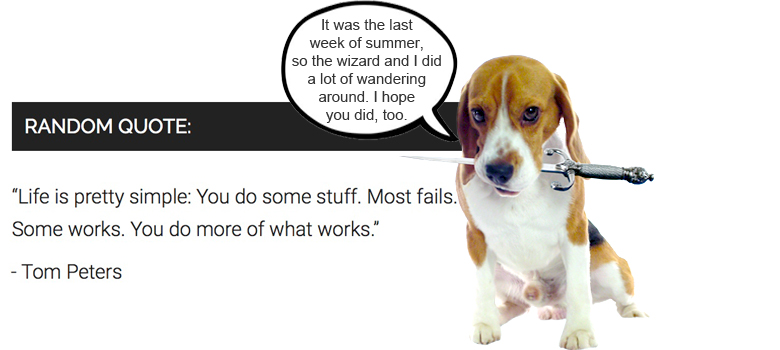You walk out the door. A person raises a forefinger and says, “Quick question.”
And then they tie you up for the next 30 minutes.
Have you ever been ambushed this way?
Quick questions don’t always have quick answers and you can’t give 30 minutes to every person who raises a forefinger, so the next time you’re ambushed, smile as you continue walking and say, “Walk with me.” The questioner will invariably fall into step beside you.
If you stop walking, you’ve officially been “captured.”
A walking person is obviously headed somewhere, so “Walk with me” indicates that your time to speak with them will be over when you get to where you’re headed. When you get there, shake their hand and say, “I’m glad we got to talk.” And then disappear.
“Walk with me” is how to make sure that quick questions remain quick.
But sometimes you need to give your full attention to what a person is saying.
Tom Peters became the king of business authors in 1982 when he wrote In Search of Excellence, a book that sold 3 million copies in its first 4 years.
Today, at 75 years old, Tom Peters says listening is “the bedrock of leadership excellence,” but characterizes himself as a bad listener and “a serial interrupter.” So to help him stay focused on the other person, he writes the word “LISTEN” on the palm of his hand before walking into meetings. He says, “The focus must be on what the other person is saying, not on formulating your response. That kind of listening shows respect for the other person, and they notice it.” 1
According to Roger Dooley at Forbes.com, “Peters cites research that on average, doctors listen to a patient describing symptoms for just eighteen seconds before interrupting… Professionals who are smart and who know what they are talking about are often the worst listeners.”
I’ve noticed that people who are smart and know what they are talking about are also the worst explainers.
This is due to a disease called “the curse of knowledge” that afflicts every expert.
When speaking about a subject we know intimately, we assume our audience has a higher level of familiarity with our subject matter than they actually possess. Consequently, we believe they are “connecting the dots” when in fact they are barely following what we are saying.
To become a more effective teacher, all you have to do is add the words “which means…” to every statement of fact you make. You can do this out loud or in your mind. Either way, you will be prompted to connect the dots for your audience, and they will love you for it.
Gen Z was born between 1995 and 2015.
[which means they are between 3 and 23 years old.
which means the youngest “millennial” is currently 24 and growing older every day.
which means the future will be firmly in the hands of Gen Z in about 25 years.]
77% of Gen Z prefer reading printed books and 59% don’t trust Facebook. 2
[which means our current obsession with the internet may turn out to be a fad.]
34% of Gen Z said they were permanently leaving social media, and 64% are taking a break because “the platforms make them feel anxious or depressed.” 2
[which means social media may continue to loosen its grip on our attention.
which means there is still hope for the return of face-to-face social interaction.
which means Gen Z is reflecting the values of their grandparents who grew up in the 60’s and 70’s.
which means the pendulum of society is swinging precisely as it has for the past 3,000 years.]
Now read those 3 statements of fact without the subsequent, “which means.”
Gen Z was born between 1995 and 2015.
77% of Gen Z prefer reading printed books and 59% don’t trust Facebook.
34% of Gen Z said they were permanently leaving social media, and 64% are taking a break because “the platforms make them feel anxious or depressed.”
Did you notice how those statements of fact seem distant and flat when no interpretation is offered?
Connect the dots for your audience.
Watch them sit up and pay attention.
Roy H. Williams
1 “What’s The One Word Business Guru Tom Peters Writes On His Hand Before Meetings?” by Tom Dooley
2 “Survey shows digital-native Gen Z prefers in-person interaction with brands”
 The IRS has only recently explained who stands to profit from the so-called Section 199A deduction for qualified business income – and who will be left out. According to Rachel Sawyer, a business tax specialist, millions of small business owners stand to realize big savings on their 2018 taxes, thanks to revisions of the federal tax code. Interested? Join roving reporter Rotbart as Rachel delves into the nuances of the new tax code and explains how to take maximum advantage of the savings it offers. If you qualify, Section 199A could mean tens of thousands of dollars of extra cash in your pocket. MondayMorningRadio.com, of course.
The IRS has only recently explained who stands to profit from the so-called Section 199A deduction for qualified business income – and who will be left out. According to Rachel Sawyer, a business tax specialist, millions of small business owners stand to realize big savings on their 2018 taxes, thanks to revisions of the federal tax code. Interested? Join roving reporter Rotbart as Rachel delves into the nuances of the new tax code and explains how to take maximum advantage of the savings it offers. If you qualify, Section 199A could mean tens of thousands of dollars of extra cash in your pocket. MondayMorningRadio.com, of course.

